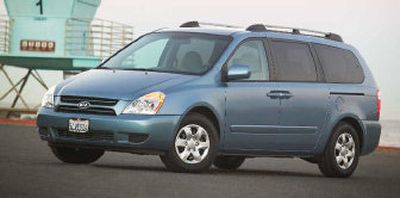Add Sedona to your minivan list

We’ve written this story before.
It’s all about a) how minivans still matter and b) how the Koreans keep making big gains.
See? It’s a yawner.
There is a twist, though. And we’ll get to that in a moment.
But first, from the top: Minivans are deader than a parrot in mourning, right?
That’s the conventional wisdom but it’s not quite accurate. The segment is in decline. Companies like Ford are pulling out in favor of crossovers. Still, a million minivans are sold each year.
Chrysler bites off the biggest chunk, with a 37 percent market share. Toyota and Honda take another third of it, with Honda’s Odyssey being the only carryover van to have experienced sales gains through the first nine months of the year.
Six other companies, with a total of 10 minivan models among them, account for the balance. Among them, Kia is a significant player, with some 5.5 percent of the market. Its partner, Hyundai, is a lesser force, but together they command enough sales to justify throwing money at minivans.
So, for 2006 there’s an all-new Kia Sedona. It’s larger now — as big as the segment leaders — and better equipped. It’s lighter and has a more powerful engine. The Institute for Highway Safety names it “Best Safety Pick.”
The National Highway Transportation Safety Administration (NHTSA) ranks it among the best minivans in crash and rollover testing.
The ‘06 Sedona is more expensive — about $2,000 more than last year’s model — but is still attractively priced. A decently equipped Sedona can be had for less than $25,000.
For many buyers the warranty is the deal-closer. Kia’s 10-year/100,000-mile powertrain warranty is the best in the business. Only certain luxury cars can rival its five-year/60,000-mile basic warranty.
Paradoxically, as the quality of Kia’s vehicles improves, the big warranty becomes less of a factor for buyers — and less of a risk for Kia.
Here’s the twist we promised: Buyers can no longer assume they can waltz down to the dealership and get a steal on a great van. Depending on which makers are incentivizing which models in any give week, the Sedona is no longer a sure-thing best-buy.
It’s simple economics. As consumers come to regard Korean vehicles on par with the rest of the industry, prices will stabilize around the market norm. Van buyers are by definition less prestige-needy than other buyers (if you’re worried about image, you’re not buying a van), and thus more likely to shop some combination of price and value.
Advantage, Korea.
Secondly, Kia and Hyundai dealers have been pleased with their sales volumes but would like to squeeze a bit more profitability out of each sale. Hence, higher prices.
It’s not rocket science: Toyota and Honda climbed out of the bargain basement as soon as they were able, as well.
Kia learned another big lesson from the Japanese; crib good ideas for all you’re worth. The Sedona is loaded with features pioneered elsewhere.
From Honda comes the folding tray between the front seats and the disappearing third-row seats. Ford came up with the convex mirror that allows parents to monitor activity in the aft portion of the cabin. Chrysler was first to stack storage bins between the floor and dashboard and Toyota offered the first sliding-door roll-down windows.
In the minivan class, being first with the goodies matters less than execution and for the most part the Sedona executes.
With certain exceptions: the second-row seats fold and tumble to increase cargo room, but to keep them there, a strap must be affixed to the floor. They can be removed, but at about 60 pounds per, they’re a handful for anyone this side of Charles Atlas.
Lifting the third-row seat out from its hiding place in the floor is an awkward process requiring the use of two pull-straps.
There are two trim levels of Sedona, LX ($23,895, including destination) and EX ($26,495).
All Sedonas are equipped with second-row captains’ chairs; fold-flat third-row seating; keyless entry; power windows, mirrors and locks; tri-zone climate control; cruise control; an eight-speaker CD system and 16-inch wheels and tires.
A new engine powers both trims. It’s a 3.8-liter V-6 rated at 244 horsepower and 235 foot-pounds of torque, a 30-percent bump over last year. The standard five-speed automatic transmission has a manual-shift mode, which may seem to be gilding the minivan lily, but can come in handy when towing a load.
Its fully independent suspension is tuned to provide a controlled and dynamic ride-and-handling package. The Sedona is one of the better-handling and fun-to-drive minivans on the market, which is a nice bonus, although some drivers will prefer the cushier ride of the Sedona’s Endeavor cousin from Hyundai.
If you’ve come with us this far, you may be in the market for a minivan. If you are, don’t forget to include the Sedona on your list. It’s no longer a loss-leader, but it’s still one of the better values on the market.
It may be an old story, but it’s a good one.